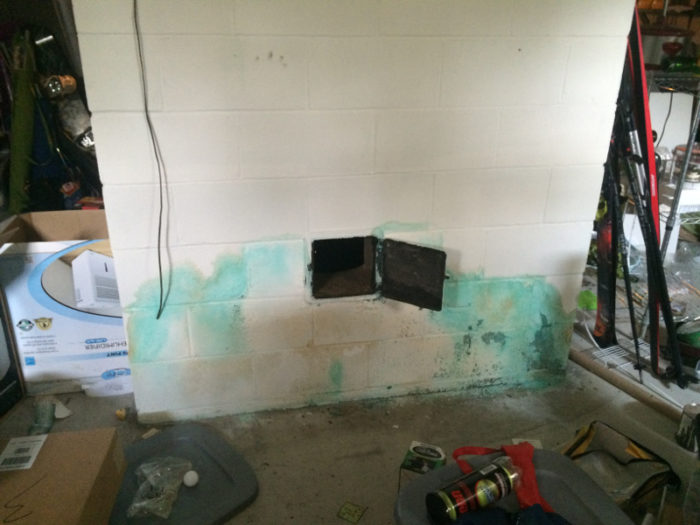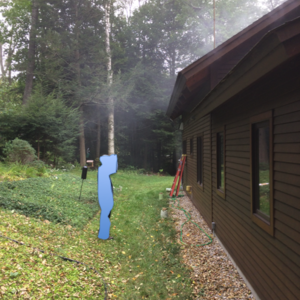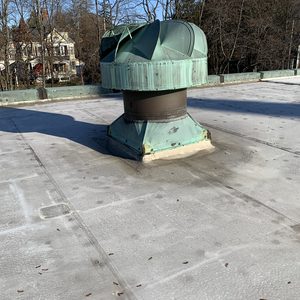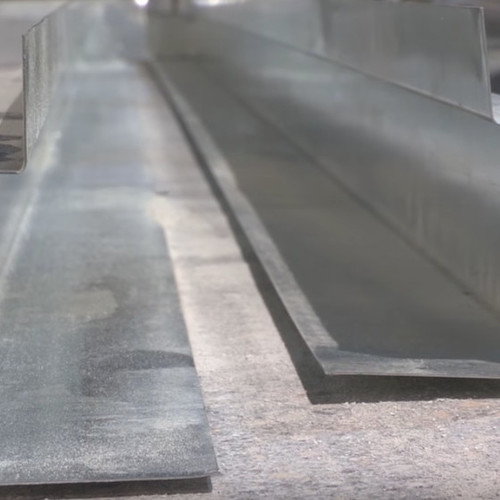
Image Credit: Images #1 through #5: Peter Yost
Image Credit: Images #1 through #5: Peter Yost The exterior of the home discussed here. An exterior view of a portion of the CMU foundation. The woodstove insert in the fireplace. A side view of the house clearly shows the chimney caps. Metallic salts like copper chloride, potassium chlorate, and lithium carbonate “burn” with blue, green, and reddish hues.
Image Credit: Image #6: GollyGforce - Living My Worst Nightmare / Flickr Drain-to-daylight pipes for the foundation perimeter drainage system.
Image Credit: Image #7: Peter Yost
A new client called me, saying that his insulation contractor urged him to contact me about some moisture problems in the home before they actually embarked on a major energy upgrade. (That was gratifying.) The home was actually moved many years ago off of a failing rubble foundation to a new concrete masonry unit (CMU) foundation on a different site.
Image #2 (bottom of page) shows the home from the front. Image #3 shows the bare CMU on the above-grade portion of CMU foundation.
But it is Image #1 (right) that is the real puzzle. Here are the puzzle pieces:
Puzzle Piece #1:
The client is certain that the blue-green staining on the CMU column built to support the massive fireplace in the living room predates their switch to a woodstove insert in the fireplace (photo 4).
Puzzle Piece #2:
The middle of the CMU column is hollow and filled with ash mounded up around the clean-out. (See the small black cast-iron door in the photo.)
It sure looked to me as though the blue-green stain was a sort of efflorescence caused by water wicking up the CMUs and carrying some sort of salt with it. But where is the water that is wicking coming from?
Puzzle Piece #3:
I always start by considering bulk water, so I thought: maybe the chimney is not capped and enough bulk water is coming down the chimney to feed the wicking. Darn — a quick check outside reveals a staunch chimney cap (see Image #5, below). Could be that this is a problem that predates the chimney cap?
Puzzle Piece #4:
The next place I always look for water is from capillary continuity with soil moisture; maybe there is no moisture barrier underneath the concrete basement slab. Before drilling a hole in the slab somewhere, I discovered a slab hole for what used to be a functioning sump. I reached down and felt a heavy plastic sheet just beneath the 4-inch concrete slab.
Puzzle Piece #5:
Stumped. It’s got to be either bulk water coming down or wicking water coming up; but how can there be soil moisture moving up into the blocks of the column when the basement slab has a moisture barrier underneath it?
When would the CMU column get built? At the same time as the perimeter walls of the foundation. Is the CMU support column on a separate footing? And was the CMU work done before the slab flatwork? You got it; it’s very likely that the moisture barrier under the slab is continuous except under the CMU fireplace column.
OK, so now we are pretty sure about the moisture source. But what about the blue-green efflorescence? Efflorescence from salts in the mortar or block is always white, not this striking blue-green.
Puzzle Piece #6:
I remember from high school chemistry that nearly all copper salts are blue or green, so a good guess is that some source of copper is inside that CMU column (or maybe from the soil below).
Remember that the blue-green staining pretty much follows the mound of the ash… So is the source of the copper salts related to what they were burning in the fireplace?
Maybe they were burning pressure-treated lumber in the fireplace; that contains copper salts, right? I sure hope not! What else would someone burn with a lot of metallic salts in it? (Remember the title: “Fanciful Fuel”?)
I can’t prove that this is the answer, because we don’t know enough about the prior occupants, but I am convinced that they spent a lot of time staring into a beautiful and colorful log fire…
Metallic salts like copper chloride, potassium chlorate, and lithium carbonate “burn” with blue, green, and reddish hues. These chemicals can be found in commercial products like Mystical Fire (see Image # 6).
The solution?
My recommendations to the homeowner on this moisture issue, along with some others, were:
- 1. Clean out the bottom ash, scrub off the blue-green efflorescence, and wait a bit before priming and painting the block, just to be sure the problem is licked.
- 2. Confirm that the footing perimeter drainage system is working, that it is relieving any moisture pressure around the foundation (I located the drain-to-daylight for the foundation perimeter drainage system; see Image #7).
- 3. Seal the above-grade portion of the CMU foundation system so it is not taking on splash-back moisture.
In addition to acting as GBA’s technical director, Peter Yost is the Vice President for Technical Services at BuildingGreen in Brattleboro, Vermont. He has been building, researching, teaching, writing, and consulting on high-performance homes for more than twenty years. An experienced trainer and consultant, he’s been recognized as NAHB Educator of the Year. Do you have a building science puzzle? Contact Pete here. You can also sign up for BuildingGreen’s email newsletter to get a free report on avoiding toxic insulation, as well as regular posts from Peter.
Weekly Newsletter
Get building science and energy efficiency advice, plus special offers, in your inbox.















One Comment
Test for arsenic?
Thanks for a fun puzzler.
I think, and I hope, that you are right that it's copper from colored-flame additives. But the pressure treated lumber possibility seems plausible enough that I'd want to test an ash sample for arsenic before undertaking a cleanup without careful controls on the dust.
Another possibility that occurred to me was a problem with copper chimney flashing somehow leaking into the chimney, which could explain the moisture and the copper. But it's a serious stretch of imagination to think of how a flashing problem would feed water in to the chimney rather than into the attic.
Log in or create an account to post a comment.
Sign up Log in